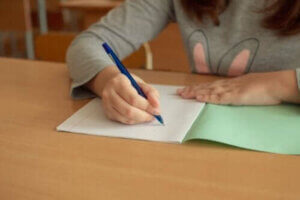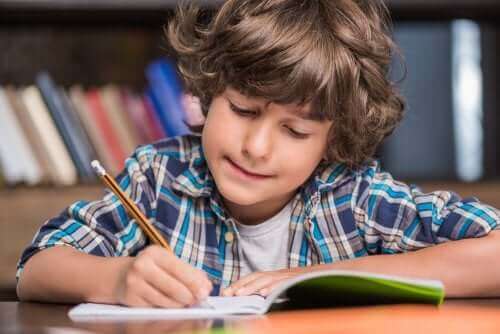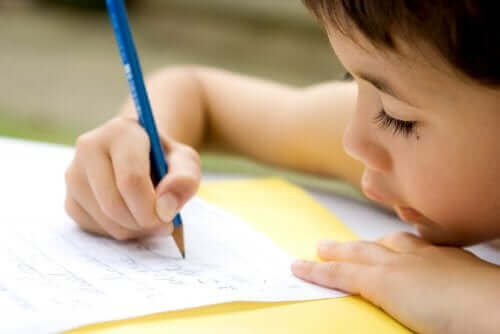The Symptoms of Dysgraphia in Children

In this day and age, the ability to know how to write is fundamental to proper development. But there’s a learning disorder called dysgraphia that affects this ability. For this reason, we’ve prepared the following article that describes the symptoms of dysgraphia in children.
Writing difficulties can affect a child’s entire academic performance. Therefore, it’s essential to treat the problem through psycho-pedagogical intervention. Moreover, it’s important to detect this disorder as soon as possible, so that the child can start receiving help to face dysgraphia with the least possible repercussion and affectation.
The cognitive processes of writing
Writing consists of transforming an idea into graphic characters. Thus, to perform this action, four cognitive processes take place:
- Motor: In charge of producing the letters or graphic signs
- Lexicon: Necessary for the writing of words
- Syntactic: Involved in the production of sentences
- Planning: Activated when writing a text
These mental operations take place in a sequential order. So, according to psychologist Fernando Cuetos, these are the steps that occur when writing:

- Planning of the message: This requires selecting the information from one’s memory, organizing it correctly, and checking if the ideas fit the proposed objectives.
- Transmission of the message: This involves building certain syntactic structures. What’s more, it takes place according to the type of grammatical sentence (passive, interrogative, etc.) and the functions of the words (articles, adverbs, prepositions, etc.).
- Search in the lexical storage: Choosing the appropriate words. This action is carried out in one of two ways. For one, through the orthographic route (direct recovery of the mental lexicon). Or it can take place through the phonological route (obtaining spelling by applying the rules of grapheme-phoneme conversion).
- Activation of the motor processes or muscular movements: These allow for the graphic representation of each letter or punctuation mark.
Therefore, although writing seems to be a simple skill, it’s actually a very complex action that, as a person develops and trains it, becomes an automated skill.
Symptoms of dysgraphia in children
Dysgraphia falls under the category of specific learning disabilities and is characterized by the presence of writing difficulties. Thus, Portellano defines this difficulty as follows:
“Dysgraphia is a writing disorder that affects form or meaning and is of a functional type. It occurs in children with normal intellectual capacity, with adequate environmental stimulation and without intense neurological, sensory, motor or affective disorders.”
– Portellano –
In short, and in general, we can say that the symptoms of dysgraphia in children are the following:
- Writing that is illegible or difficult to understand
- Excessively large print or irregularity in its dimension
- Omissions, additions, substitutions and reversals of letters
- Skewing in the line or in the letters
- Distorted shape of letters
- Slow and clumsy writing
- Discontinuous and unsure strokes
- Unusual pen or pencil grip when writing
- Poor spontaneous writing content
- Misuse of the spacing of letters or words
- Difficulties with turns and rotations when writing
- Mirrored or specular writing
- Wrong position of the body and specifically the wrist when writing
- Incorrect syllabic connections
- Poor or unclear presentation

Evaluation and intervention of dysgraphia in children
Children who may have dysgraphia will need a psycho-pedagogical evaluation, through observation and the use of a psychometric test.
Then, once a child receives a dysgraphia diagnosis, Lucchini recommends using the cursive method because it:
- Favors the continuity of the movement
- Facilitates ease and dynamism in writing
- Allows for the perception of the word as a whole
- Tends to be resistant to forgetfulness in memory
Also, Lucchini states that motor relaxation should be encouraged by means of free painting. In addition, it’s also important to stimulate the verbalization of writing and to control the child’s body posture when writing. Therefore, it’s important to make sure that the child holds the pencil and that the wrist is resting on the paper.
In short, these simple actions can improve the writing problems associated with dysgraphia in children.
In this day and age, the ability to know how to write is fundamental to proper development. But there’s a learning disorder called dysgraphia that affects this ability. For this reason, we’ve prepared the following article that describes the symptoms of dysgraphia in children.
Writing difficulties can affect a child’s entire academic performance. Therefore, it’s essential to treat the problem through psycho-pedagogical intervention. Moreover, it’s important to detect this disorder as soon as possible, so that the child can start receiving help to face dysgraphia with the least possible repercussion and affectation.
The cognitive processes of writing
Writing consists of transforming an idea into graphic characters. Thus, to perform this action, four cognitive processes take place:
- Motor: In charge of producing the letters or graphic signs
- Lexicon: Necessary for the writing of words
- Syntactic: Involved in the production of sentences
- Planning: Activated when writing a text
These mental operations take place in a sequential order. So, according to psychologist Fernando Cuetos, these are the steps that occur when writing:

- Planning of the message: This requires selecting the information from one’s memory, organizing it correctly, and checking if the ideas fit the proposed objectives.
- Transmission of the message: This involves building certain syntactic structures. What’s more, it takes place according to the type of grammatical sentence (passive, interrogative, etc.) and the functions of the words (articles, adverbs, prepositions, etc.).
- Search in the lexical storage: Choosing the appropriate words. This action is carried out in one of two ways. For one, through the orthographic route (direct recovery of the mental lexicon). Or it can take place through the phonological route (obtaining spelling by applying the rules of grapheme-phoneme conversion).
- Activation of the motor processes or muscular movements: These allow for the graphic representation of each letter or punctuation mark.
Therefore, although writing seems to be a simple skill, it’s actually a very complex action that, as a person develops and trains it, becomes an automated skill.
Symptoms of dysgraphia in children
Dysgraphia falls under the category of specific learning disabilities and is characterized by the presence of writing difficulties. Thus, Portellano defines this difficulty as follows:
“Dysgraphia is a writing disorder that affects form or meaning and is of a functional type. It occurs in children with normal intellectual capacity, with adequate environmental stimulation and without intense neurological, sensory, motor or affective disorders.”
– Portellano –
In short, and in general, we can say that the symptoms of dysgraphia in children are the following:
- Writing that is illegible or difficult to understand
- Excessively large print or irregularity in its dimension
- Omissions, additions, substitutions and reversals of letters
- Skewing in the line or in the letters
- Distorted shape of letters
- Slow and clumsy writing
- Discontinuous and unsure strokes
- Unusual pen or pencil grip when writing
- Poor spontaneous writing content
- Misuse of the spacing of letters or words
- Difficulties with turns and rotations when writing
- Mirrored or specular writing
- Wrong position of the body and specifically the wrist when writing
- Incorrect syllabic connections
- Poor or unclear presentation

Evaluation and intervention of dysgraphia in children
Children who may have dysgraphia will need a psycho-pedagogical evaluation, through observation and the use of a psychometric test.
Then, once a child receives a dysgraphia diagnosis, Lucchini recommends using the cursive method because it:
- Favors the continuity of the movement
- Facilitates ease and dynamism in writing
- Allows for the perception of the word as a whole
- Tends to be resistant to forgetfulness in memory
Also, Lucchini states that motor relaxation should be encouraged by means of free painting. In addition, it’s also important to stimulate the verbalization of writing and to control the child’s body posture when writing. Therefore, it’s important to make sure that the child holds the pencil and that the wrist is resting on the paper.
In short, these simple actions can improve the writing problems associated with dysgraphia in children.
All cited sources were thoroughly reviewed by our team to ensure their quality, reliability, currency, and validity. The bibliography of this article was considered reliable and of academic or scientific accuracy.
- Asorey, M. J. F. y Fernández, P. F. (2014). Dificultades de aprendizaje y trastornos del desarrollo. Ediciones Pirámide.
- Berruezo, P. P. (2004). Entendiendo la disgrafía. El ajuste visomotor en la escritura manual. Revista iberoamericana de psicomotricidad y técnicas corporales, (14), 39-70.
- Cuetos, F. (2009). Psicología de la escritura. Madrid: Wolters Kluwer España.
- Rivas, R., & Fernández, P. (1994). Dislexia, disortografía y disgrafía. Madrid. Pirámide.
This text is provided for informational purposes only and does not replace consultation with a professional. If in doubt, consult your specialist.








